Key takeaways:
- Feedback blends praise and critique, encouraging artists to grow and refine their craft despite emotional challenges.
- Constructive criticism serves as a vital tool for artists to innovate and connect more deeply with their audience.
- Incorporating feedback from performance experiences fosters improved engagement and connection with the audience.
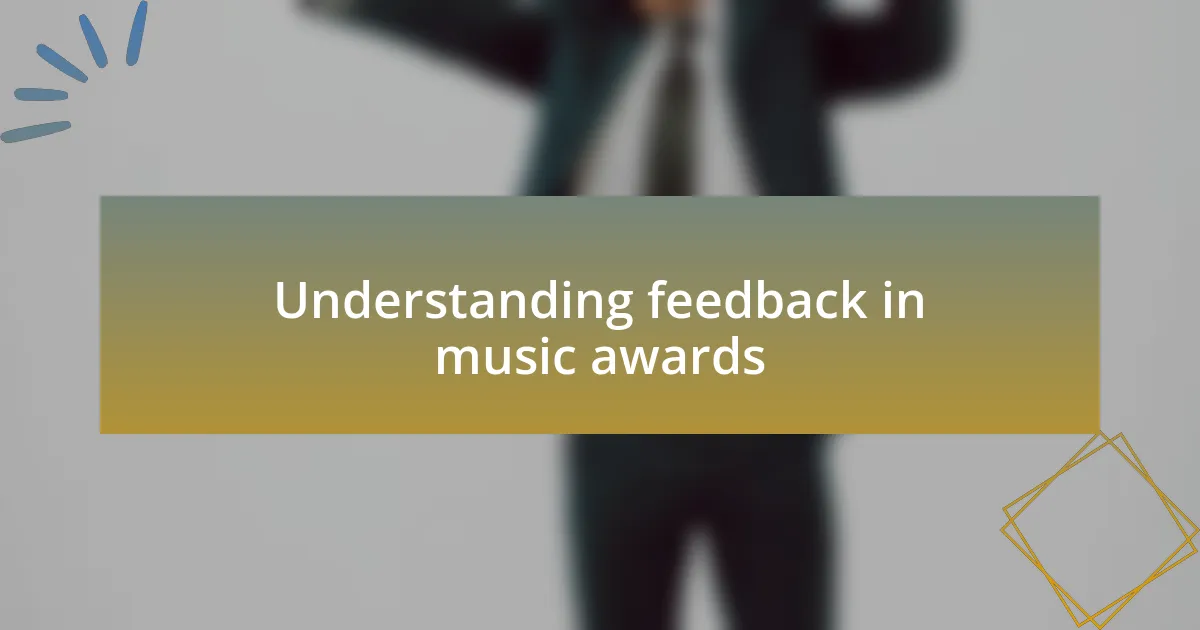
Understanding feedback in music awards
Feedback in the realm of music awards can be a double-edged sword. I remember the first time I received critiques on my work; it felt personal, almost like a validation of my worth. But then I realized, isn’t constructive criticism a chance to grow and refine my artistic voice?
When you dive into the feedback received during award seasons, it’s often laced with both praise and constructive critiques. I recall the mixed reviews an artist received after a grand performance—some celebrated their originality, while others questioned their technical proficiency. This experience made me ponder: how can artists sift through the noise and focus on what truly matters? I believe that understanding the intent behind the feedback helps in finding clarity among the chaos.
Moreover, the emotional weight of feedback can vary. Hearing positive comments can uplift an artist’s spirit, while harsh critiques can sting. I once watched a nominee in tears, torn between feeling proud of their nomination and crushed by negative reviews. This moment taught me that feedback isn’t just about the words; it embodies the hopes and dreams of every artist striving for recognition. How do you process such emotionally charged feedback? It’s a journey, one filled with reflection and resilience.
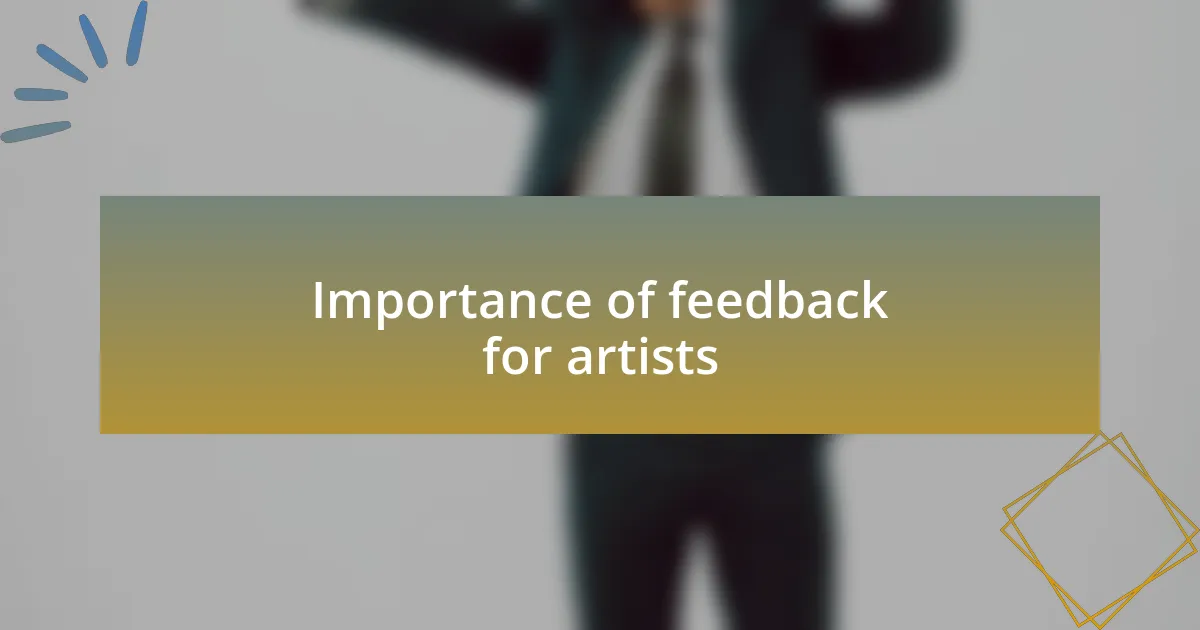
Importance of feedback for artists
Feedback holds immense significance for artists, acting as a compass guiding their creative journey. I remember a time when I received feedback after releasing a song; the comments ranged from heartfelt praise to pointed critiques. It struck me how this blend of reactions not only highlighted my strengths but also shed light on areas needing growth. Isn’t it fascinating how one piece of work can evoke such varied responses?
The relationship between feedback and growth is vital. There was an instance when a fellow artist received feedback that seemed harsh initially. However, after taking time to reflect, they adjusted their approach and soon found their audience resonating more deeply with their music. This experience reinforced my belief that what may feel like a setback often paves the way for breakthroughs. How much could an artist miss out on by dismissing valuable insights?
Furthermore, feedback often serves as a reality check, reminding artists of their place within the larger music landscape. I once watched a seasoned artist express genuine gratitude for criticism during an awards panel, stating that it kept their passion alive and pushed them to innovate. It made me think—how often do we step back to appreciate the lessons hidden beneath constructive feedback? For artists, embracing this learning opportunity can lead to formidable growth.
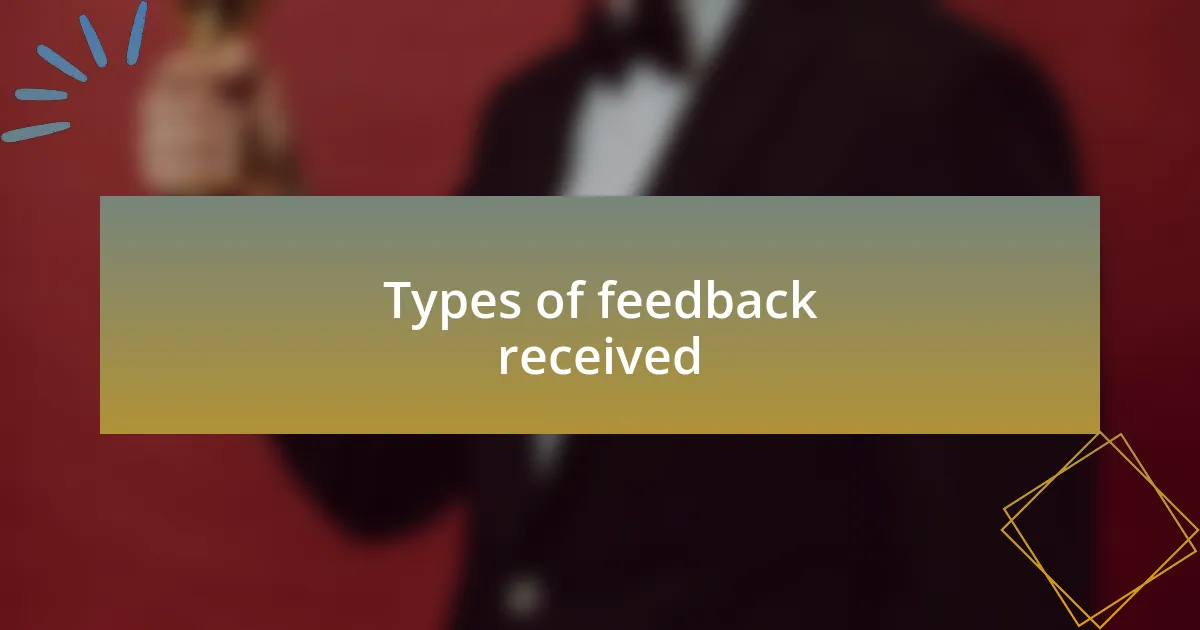
Types of feedback received
Feedback comes in various forms, and I’ve noticed that the most common types are positive reinforcement, constructive criticism, and emotional responses. Positive remarks boost confidence and inspire creativity, like when a fan shared how my song helped them through a tough time. Their words reminded me of why I create music in the first place—it’s gratifying to know my work can touch people’s lives.
On the other hand, constructive criticism can often feel daunting. There was a significant moment when a reviewer pointed out that my latest track lacked depth compared to my previous work. Initially, I felt disheartened, but that push made me dive deeper into my songwriting process. Isn’t it surprising how a single critique can motivate an artist to explore new dimensions in their craft?
Lastly, emotional responses from fellow artists and fans strike a chord that often resonates on a personal level. I once received a heartfelt message from an emerging artist who found solace in my lyrics during their own struggles. These raw expressions of connection remind me that feedback is not just about improvement; it’s about building a community that supports and uplifts one another. How often do we acknowledge the emotional weight of feedback?
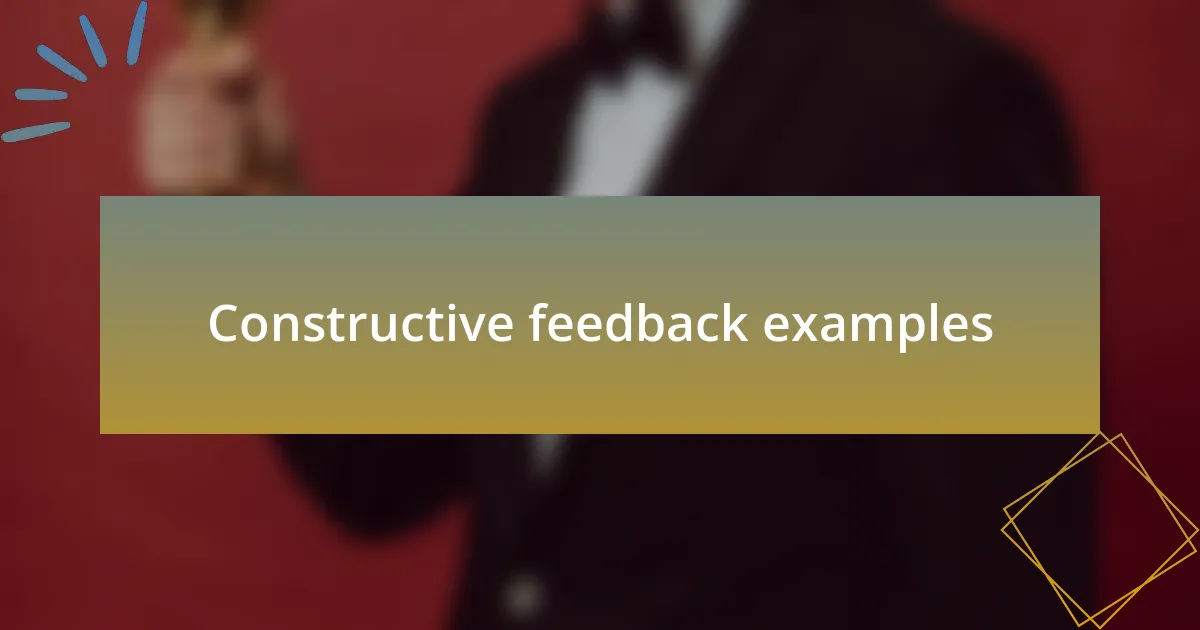
Constructive feedback examples
Constructive feedback can often shape an artist’s journey, as I’ve experienced firsthand. For instance, a mentor once suggested that I should experiment with different genres to expand my range. At first, I hesitated; stepping outside my comfort zone was intimidating. But ultimately, that advice propelled me to create a fusion track that surprised both my audience and myself. Isn’t it fascinating how stepping back can lead to a leap forward?
Another example that stands out involved a producer who pointed out that my vocal delivery needed more variation to keep listeners engaged. Initially, the critique stung, but I took it to heart. After re-recording with more dynamics and emotion, I discovered a new layer to my performance. This process made me realize that constructive feedback can be a gift, offering a fresh perspective that enriches the final product.
I also remember when a close friend, who is an avid music lover, suggested I pay more attention to song structure. Their insight prompted me to analyze hit songs and understand what made them resonate. Incorporating this feedback not only improved my work but also allowed me to connect better with my audience. How often do we consider that feedback from those around us can unlock entirely new approaches?
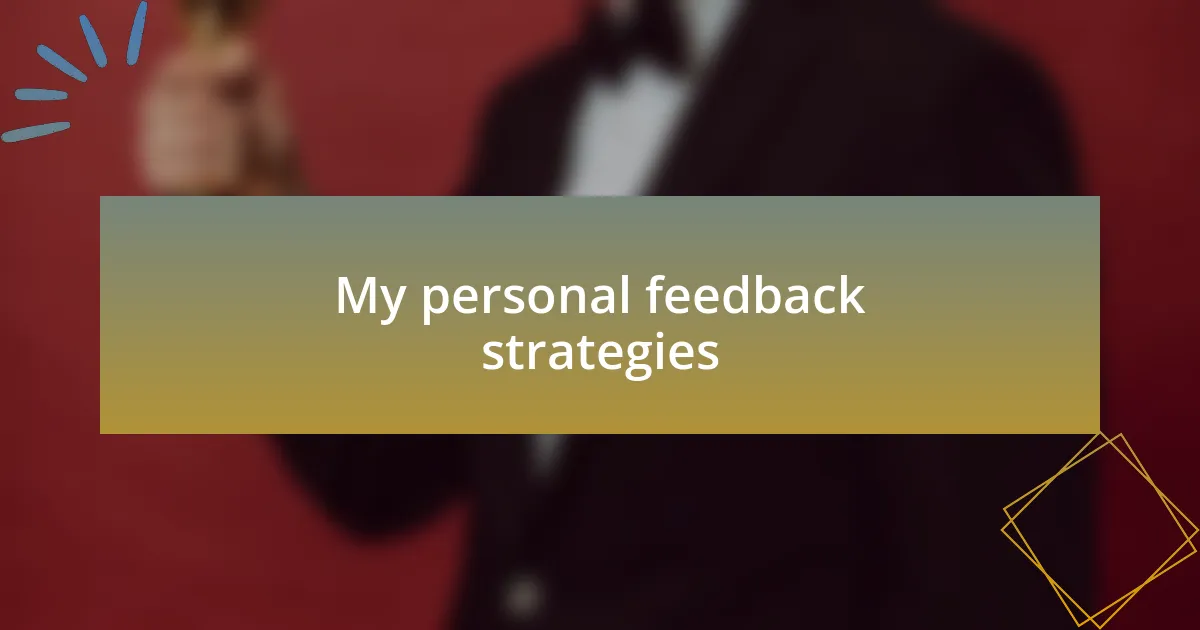
My personal feedback strategies
When it comes to handling feedback, I often rely on a three-step approach: reflection, action, and integration. For example, after receiving critical input on my songwriting, I took a moment to sit with those comments rather than react immediately. This period of reflection allowed me to really digest the feedback, assess its validity, and decide how it fit into my creative vision.
I also make it a point to actively seek out feedback from diverse sources. This has included everything from informal jam sessions with fellow musicians to listening sessions with friends who are not in the industry. By doing so, I get a variety of perspectives that challenge my own thinking and push me to question, “What if?” This questioning often leads to creative breakthroughs that I wouldn’t have achieved alone.
Lastly, I believe in maintaining an open dialogue after receiving feedback. I recall a moment when a collaborator shared their thoughts on a project late in the game, and instead of shutting down, I engaged in a constructive conversation about their ideas. This not only led to a richer final product but also strengthened our partnership. Isn’t it incredible how collaboration can transform individual feedback into a collective masterpiece?
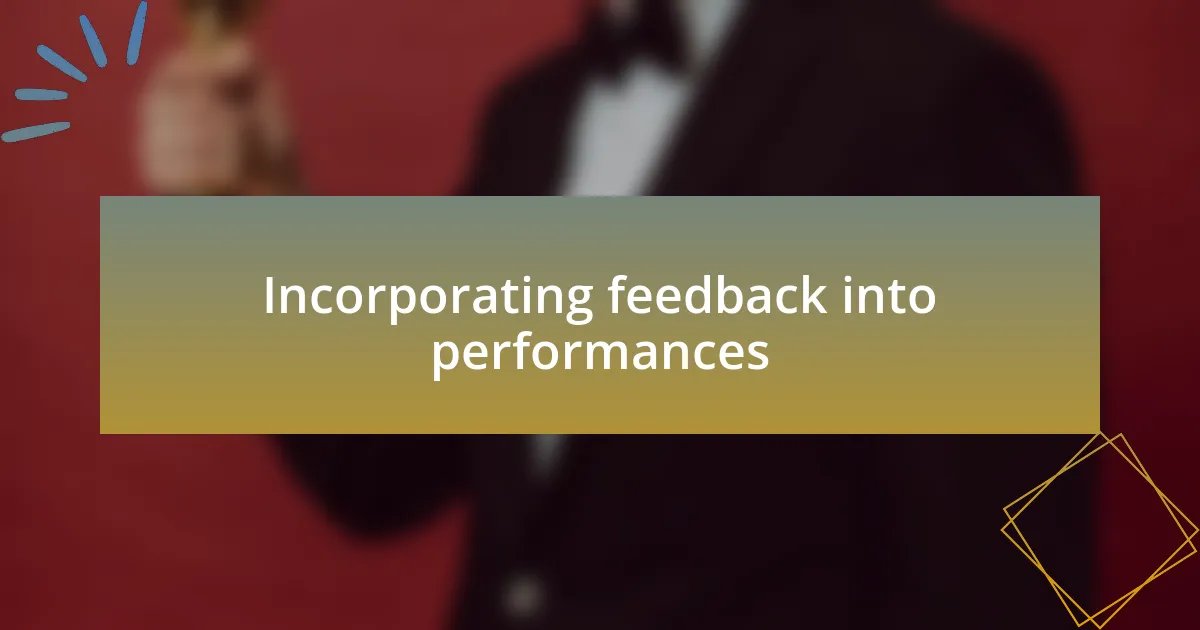
Incorporating feedback into performances
Incorporating feedback into performances has truly reshaped the way I approach live shows. For instance, after a particularly tough critique about the energy level during a set, I committed to analyzing video recordings of my performances. Seeing myself through the eyes of an audience member was eye-opening; it was clear that I had the potential to elevate the experience for everyone present.
I’ve also learned that integrating feedback is an ongoing process. During rehearsals for a recent concert, I experimented with elements based on audience feedback from previous gigs. When one audience member suggested I engage more with the crowd, I decided to weave storytelling into my performance, sharing little anecdotes between songs. The response was overwhelmingly positive, reminding me of the power of connection. How often do we miss out on those opportunities because we fear stepping outside our comfort zones?
Finally, I always find value in revisiting performances with fresh ears after some time has passed. After a recent awards show, I went back to listen to the recordings while noting areas for improvement. It’s fascinating how feedback can become a part of my growth journey, transforming past performances into blueprints for future successes. Isn’t it amazing how a few insights can spark a new direction in our musical journey?